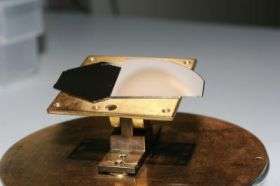Nanowires hold promise for more affordable solar cells

Millions of nearly invisible wires may hold the answer to making solar cells a more affordable source of alternative energy.
The Department of Engineering Physics at McMaster University, Cleanfield Energy and the Ontario Centres of Excellence (OCE) have formed a partnership to pursue the commercialization of nanowire technology in the production of solar cells.
The particular type of nanowire technology developed at McMaster is able to trap more sunlight and convert it to electricity more efficiently than traditional solar cells.
“One of the biggest obstacles to widespread use of solar cells as a clean source of energy is cost,” said Ray LaPierre, assistant professor of engineering physics at McMaster University and project leader for the collaboration. “Our work with nanowire fabrication at this stage shows the potential for greater energy efficiency with less costly materials.”
Nanowires are one-dimensional structures with controlled lengths of one to five microns and diameters of 10 to 100 nanometres (a thousand times thinner than a human hair). They offer many advantages over thin film and crystal silicon currently used in solar cell production including low material utilization, use of low-cost substrates, defect-free materials with high conversion efficiency, and strong light trapping and absorption.
“We have been looking to add solar cells to our line of alternative energy products,” said Tony Verrelli, president of Cleanfield Energy, manufacturers of the V3.5 vertical axis wind turbine. “Dr. LaPierre’s nanowire research has the potential to make solar cells accessible to a wider range of people looking for a more sustainable energy source to meet their power needs.”
The three-year initiative is valued at more than half a million dollars. The Ontario Centres of Excellence is providing $279,000 in funding and Cleanfield Energy is investing $300,000. McMaster is providing researchers and facilities. It will use the funding to add a post-doctoral fellow, and PhD and Master’s students to the research team, and for materials and supplies.
“Supporting forward-thinking companies like Cleanfield and research centres like McMaster is what will help propel Ontario into an alternative energy leader,” said Don Wilford, managing director of OCE’s Centre of Excellence for Photonics. “This initiative shows strong promise in addressing the cost effectiveness of solar energy.”
Source: McMaster University




















